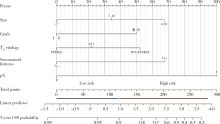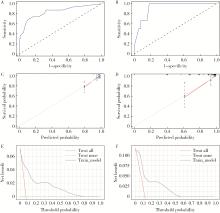北京大学学报(医学版) ›› 2024, Vol. 56 ›› Issue (4): 673-679. doi: 10.19723/j.issn.1671-167X.2024.04.021
非转移性T3a肾细胞癌患者3年肿瘤特异性生存期预测
周泽臻,邓绍晖,颜野,张帆,郝一昌,葛力源,张洪宪,王国良,张树栋*( )
)
- 北京大学第三医院泌尿外科,北京 100191
Predicting the 3-year tumor-specific survival in patients with T3a non-metastatic renal cell carcinoma
Zezhen ZHOU,Shaohui DENG,Ye YAN,Fan ZHANG,Yichang HAO,Liyuan GE,Hongxian ZHANG,Guoliang WANG,Shudong ZHANG*( )
)
- Department of Urology, Peking University Third Hospital, Beijing 100191, China
摘要:
目的: 预测非转移性T3a肾细胞癌患者术后3年肿瘤特异性生存期(cancer specific survival, CSS)。方法: 选择2013年3月至2021年2月在北京大学第三医院泌尿外科行手术治疗且术后组织病理学诊断证实为T3aN0-1M0的肾细胞癌患者的病例资料进行回顾性分析,共收集到符合要求的患者336例,以4 ∶ 1的比例随机划分为训练队列(268例)和内部验证队列(68例)。采用双向Lasso回归筛选变量绘制预测T3aN0-1M0肾细胞癌患者术后3年CSS的列线图。利用一致性指数(C指数)、时间依赖性ROC曲线下面积(area under the curve,AUC)、校准曲线、决策曲线(decision curve analysis, DCA)来评估列线图的判别和校准能力及临床效益。根据列线图得分划分危险分层,并用Kaplan-Meier生存分析和Log-rank检验比较不同危险分层患者的无进展生存期(progress free survival, PFS)和CSS。结果: 训练队列和验证队列的基线资料组间差异均无统计学意义(P>0.05)。根据Lasso回归筛选结果,最终纳入肿瘤最大径、组织学分级、肉瘤样变、T3a特征、淋巴结转移5个变量构建列线图。列线图的训练队列和内部验证队列的一致性指数分别为0.808(0.708~0.907)、0.903(0.838~0.969);3年肿瘤特异性生存期的AUC分别为0.843(0.725~0.961)、0.923(0.844~1.002);各队列的校准曲线均显示实际CSS与预测概率之间具有高度的一致性;各队列的DCA曲线均显示列线图在临床上具有良好的净效益;两个队列共计336例患者,其中肿瘤特异性死亡35例,术后复发69例。根据列线图将0~117分的患者划分为低危组,119-284分的患者划分为高危组,其中低危组(282例)肿瘤特异性死亡16例,术后复发36例,高危组(54例)肿瘤特异性死亡19例,术后复发33例。低危组和高危组的PFS和CSS差异有统计学意义(P<0.000 1)。结论: 构建并验证了预测非转移性T3a肾细胞癌患者术后3年CSS的列线图预测模型,可协助临床精准评估此类患者的远期预后。
中图分类号:
- R737.11
| 1 |
Elkassem AA , Allen BC , Sharbidre KG , et al. Update on the role of imaging in clinical staging and restaging of renal cell carcinoma based on the AJCC 8th edition, from the AJR special series on cancer staging[J]. AJR Am J Roentgenol, 2021, 217 (3): 541- 555.
doi: 10.2214/AJR.21.25493 |
| 2 |
Guo P , Wang Y , Han Y , et al. Development and validation of a nomogram to predict postoperative cancer-specific survival of patients with nonmetastatic T3a renal cell carcinoma[J]. Urol Oncol, 2021, 39 (12): 835.e19- 835.e27.
doi: 10.1016/j.urolonc.2021.06.014 |
| 3 |
Musso G , Fallara G , Rosiello G , et al. Differential prognostic value of extrarenal involvement in patients with non-metastatic renal cell cancer[J]. Clin Genitourin Cancer, 2023, 21 (4): e279- e285.e1.
doi: 10.1016/j.clgc.2023.02.008 |
| 4 |
Shah PH , Lyon TD , Lohse CM , et al. Prognostic evaluation of perinephric fat, renal sinus fat, and renal vein invasion for patients with pathological stage T3a clear-cell renal cell carcinoma[J]. BJU Int, 2019, 123 (2): 270- 276.
doi: 10.1111/bju.14523 |
| 5 |
Li L , Shi L , Zhang J , et al. The critical impact of tumor size in predicting cancer special survival for T3aM0M0 renal cell carcinoma: A proposal of an alternative T3aN0M0 stage[J]. Cancer Med, 2021, 10 (2): 605- 614.
doi: 10.1002/cam4.3629 |
| 6 |
Lam JS , Klatte T , Patard JJ , et al. Prognostic relevance of tumour size in T3a renal cell carcinoma: A multicentre experience[J]. Eur Urol, 2007, 52 (1): 155- 162.
doi: 10.1016/j.eururo.2007.01.106 |
| 7 |
Tan WS , Koelker M , Campain N , et al. Comparison of long-term outcomes for young and healthy patients with cT1a and cT3a renal cell carcinoma treated with partial nephrectomy[J]. Eur Urol Focus, 2023, 9 (2): 333- 335.
doi: 10.1016/j.euf.2022.09.018 |
| 8 | Chung DY , Kang DH , Kim JW , et al. Comparison of oncologic outcomes between partial nephrectomy and radical nephrectomy in patients who were upstaged from cT1 renal tumor to pT3a renal cell carcinoma: An updated systematic review and meta-analysis[J]. Ther Adv Urol, 2020, 12, 1756287220981508. |
| 9 |
Deng H , Fan Y , Yuan F , et al. Partial nephrectomy provides equivalent oncologic outcomes and better renal function preservation than radical nephrectomy for pathological T3a renal cell carcinoma: A meta-analysis[J]. Int Braz J Urol, 2021, 47 (1): 46- 60.
doi: 10.1590/s1677-5538.ibju.2020.0167 |
| 10 |
Liu H , Kong QF , Li J , et al. A meta-analysis for comparison of partial nephrectomy vs. radical nephrectomy in patients with pT3a renal cell carcinoma[J]. Transl Androl Urol, 2021, 10 (3): 1170- 1178.
doi: 10.21037/tau-20-1262 |
| 11 |
Liu Z , Yang Z , Li J , et al. Partial versus radical nephrectomy for the treatment of pT3aN0M0 renal cell carcinoma: A propensity score analysis[J]. Asian J Surg, 2023, 46 (9): 3607- 3613.
doi: 10.1016/j.asjsur.2023.04.058 |
| [1] | 刘园梅, 傅义程, 郝靖欣, 张福春, 刘慧琳. 老年髋部骨折患者住院期间发生术后心力衰竭的列线图预测模型的构建及验证[J]. 北京大学学报(医学版), 2024, 56(5): 874-883. |
| [2] | 李志存, 吴天俣, 梁磊, 范宇, 孟一森, 张骞. 穿刺活检单针阳性前列腺癌术后病理升级的危险因素分析及列线图模型构建[J]. 北京大学学报(医学版), 2024, 56(5): 896-901. |
| [3] | 欧俊永,倪坤明,马潞林,王国良,颜野,杨斌,李庚午,宋昊东,陆敏,叶剑飞,张树栋. 肌层浸润性膀胱癌合并中高危前列腺癌患者的预后因素[J]. 北京大学学报(医学版), 2024, 56(4): 582-588. |
| [4] | 刘帅,刘磊,刘茁,张帆,马潞林,田晓军,侯小飞,王国良,赵磊,张树栋. 伴静脉癌栓的肾上腺皮质癌的临床治疗及预后[J]. 北京大学学报(医学版), 2024, 56(4): 624-630. |
| [5] | 虞乐,邓绍晖,张帆,颜野,叶剑飞,张树栋. 具有低度恶性潜能的多房囊性肾肿瘤的临床病理特征及预后[J]. 北京大学学报(医学版), 2024, 56(4): 661-666. |
| [6] | 方杨毅,李强,黄志高,陆敏,洪锴,张树栋. 睾丸鞘膜高分化乳头状间皮肿瘤1例[J]. 北京大学学报(医学版), 2024, 56(4): 741-744. |
| [7] | 曾媛媛,谢云,陈道南,王瑞兰. 脓毒症患者发生正常甲状腺性病态综合征的相关因素[J]. 北京大学学报(医学版), 2024, 56(3): 526-532. |
| [8] | 苏俊琪,王晓颖,孙志强. 舌鳞状细胞癌根治性切除术后患者预后预测列线图的构建与验证[J]. 北京大学学报(医学版), 2024, 56(1): 120-130. |
| [9] | 李建斌,吕梦娜,池强,彭一琳,刘鹏程,吴锐. 干燥综合征患者发生重症新型冠状病毒肺炎的早期预测[J]. 北京大学学报(医学版), 2023, 55(6): 1007-1012. |
| [10] | 刘欢锐,彭祥,李森林,苟欣. 基于HER-2相关基因构建风险模型用于膀胱癌生存预后评估[J]. 北京大学学报(医学版), 2023, 55(5): 793-801. |
| [11] | 薛子璇,唐世英,邱敏,刘承,田晓军,陆敏,董靖晗,马潞林,张树栋. 青年肾肿瘤伴瘤栓的临床病理特征及预后分析[J]. 北京大学学报(医学版), 2023, 55(5): 802-811. |
| [12] | 毛海,张帆,张展奕,颜野,郝一昌,黄毅,马潞林,褚红玲,张树栋. 基于MRI前列腺腺体相关参数构建腹腔镜前列腺癌术后尿失禁的预测模型[J]. 北京大学学报(医学版), 2023, 55(5): 818-824. |
| [13] | 卢汉,张建运,杨榕,徐乐,李庆祥,郭玉兴,郭传瑸. 下颌牙龈鳞状细胞癌患者预后的影响因素[J]. 北京大学学报(医学版), 2023, 55(4): 702-707. |
| [14] | 时云飞,王豪杰,刘卫平,米岚,龙孟平,刘雁飞,赖玉梅,周立新,刁新婷,李向红. 血管免疫母细胞性T细胞淋巴瘤临床与分子病理学特征分析[J]. 北京大学学报(医学版), 2023, 55(3): 521-529. |
| [15] | 许云屹,苏征征,郑林茂,张孟尼,谭珺娅,杨亚蓝,张梦鑫,徐苗,陈铌,陈雪芹,周桥. 转录通读环状RNA rt-circ-HS促进低氧诱导因子1α表达和肾癌细胞增殖与侵袭[J]. 北京大学学报(医学版), 2023, 55(2): 217-227. |
|
||








